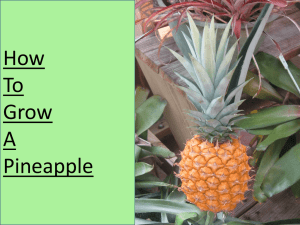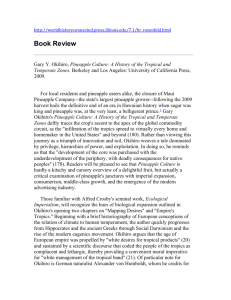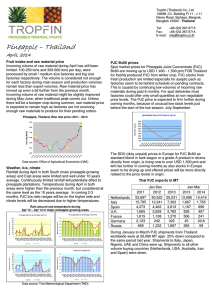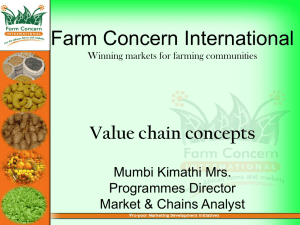Workshop on experimental methods in social science and
advertisement
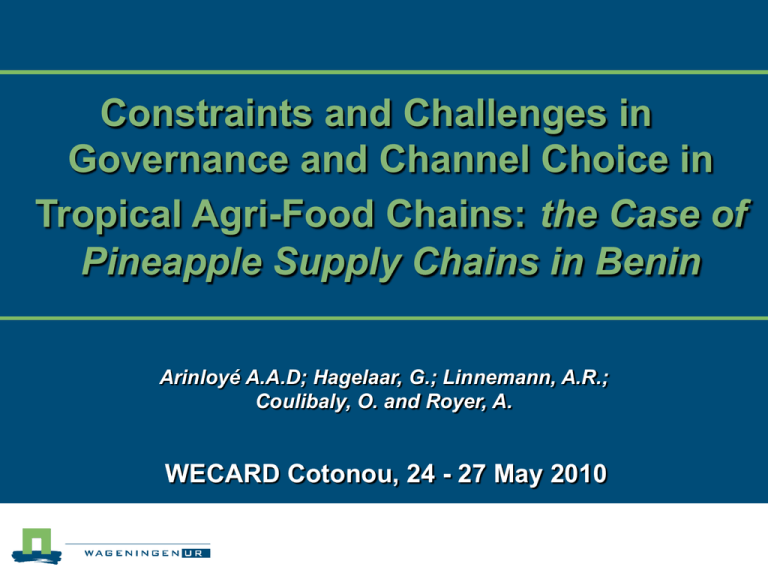
Constraints and Challenges in Governance and Channel Choice in Tropical Agri-Food Chains: the Case of Pineapple Supply Chains in Benin Arinloyé A.A.D; Hagelaar, G.; Linnemann, A.R.; Coulibaly, O. and Royer, A. WECARD Cotonou, 24 - 27 May 2010 Outline Problem statement and objectives Background on pineapple chains Theoretical framework Methodology Results and conclusion Problem statement Important issues in the pineapple supply chain: High transaction costs: cheating, opportunism behavior, corruption, weak logistic facilities, etc. Limited collective action: lack of organized governance structure Irregular and scattered supply by smallholders Thin assembly markets Poor and variable product quality Understanding chains’ coordination and organization is needed for a co-innovative quality performance of Beninese pineapple supply chains Research objective Analyze the organization and structure of pineapple supply chains in Benin with a focus on chain governance and channel choice for quality improvement Key Questions Answering the following questions leads to reach the research objective : Which actors are directly and indirectly involved in pineapple activities? What kind of linkages and flows exist in the cooperative networks and how do they affect pineapple quality and chain performance? What are the pineapple quality issues that are hampering actors’ access to more profitable markets? Which conflicts or synergies occur between chain actors and who are involved in managing and resolving these conflicts ? Background In 2007 government selected pineapple (among others) as a spearhead to counterbalance dependence on cotton Pineapple production zones With 90% from Atlantique department Guineo Congolian Zone Background In one decade, pineapple production increased threefold from 44,836 tonnes in 1998 to 136,123 tonnes in 2008 Production(kg) Yield (kg/ha) Tonne 160000 140000 120000 100000 80000 60000 40000 20000 0 19 98 19 99 20 00 20 01 20 02 20 03 20 04 20 05 20 06 20 07 20 08 figure 1: Pineapple production and yield Source: INSAE, 2005 and FAOSTAT, 2010 Tonne/ha 70 60 50 40 30 20 10 0 Theoretical framework Firm characteristics Market choice Quality management Institutional environment Chain Governance Performance Research methodology Case study approach most indicated in responding to: • which ? • what ? • How to understand ? Information gathering • literature review, questionnaires • interviews and focus group discussions Sampling • • • • • • Input suppliers (2) Producers (20) Traders (12) Processors (5) Exporter (2) Research institutes , extension and quality control services (12) Design tests and employed tactics Design test Theoretical explanation of construct Table1. Design teststhe and tactics employed during the case study Case study tactics Construct validity Construct validity is to ensure that correct operational measures have been established for the concepts that are being studied - Multiple sources of evidence Chain - Interview respondents - Reviewing draft of case study report Internal validity Internal validity is to make sure that a causal relationship - i.e., certain conditions lead to other conditions has been established. - Pattern matching - Explanation building External validity External validity is to prove that the domain to which a case study’s findings belong can be generalized. - Specification of the population of interest - Replication logic in multiple with different chain actors in different areas - Interview protocol Reliability Reliability involves demonstrating that the findings from a case study can be repeated if the case study procedures are followed. - Clearly conceptualized constructs - Multiple indicators - Execution of pilot tests - Case study data base and records Firm Characteristics Pineapple chains are characterized by large and heterogeneous group of producers; Differences in farm size, scale of production, technical and financial capacities, access to input, land and labour Current debate for international market: MRL <= 0.5ppm (mg/kg) instead of 2ppm Institutional Environment Mismatch between producers requirements and observed interventions Low public sectors intervention and supports along the chains High transaction cost (police/gendarme harassment & rural roads conditions) Subsidized fertilizers sold on the black market Inappropriate existing credits/loan (2M fcfa for 1ha) Loans from IMF (36 and 47% APR) Loans from informal sectors (as high as 20% a day) Personal savings and relationship based financial supports Pre-financing in cash or in kind from pineapple trader or exporters Channel choice Choice of a specific chain is affected by: Price attribute (fixed vs varying) Temporary specificity Socio-cultural condition Product attributes (size) competition with other fruits 5 main chains targeted But no quantitative data available Local process to Juice, 15% Fresh Export to EU, 2% Regional Fresh Export, 40% Local Fresh consumption, 35% Dried pineapple Export, 8% Pineapple chains map Chain governance mechanisms Governance structures mainly consist of: spot market relations relational contracts collective action combination of contracts and collective action Outgrowing schemes Relying on exporter to get advice and inputs support Benefit for both involved parties Formalizing the trading with Nigeria Quality Management and control ILO; HACCP; EurepGAP; ISO, etc. Stringent norms and quality standards Reduction of export possibilities (2%) Consumer’s quality requirements on local and border markets are generally low Quality affected by : Less qualified labour and qualified competences with adapted equipments Farming systems Access to inputs (planting & fertilizers) Need of tractability system (accreditation and certification) Constraints and Challenges in Governance and Channel Choice in Tropical Agri-Food Chains: the Case of Pineapple Supply Chains in Benin Arinloyé A.A.D; Hagelaar, G.; Linnemann, A.R.; Coulibaly, O. and Royer, A. WECARD Cotonou, 24 - 27 May 2010
